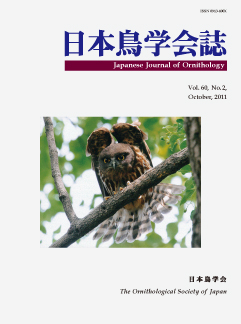All issues

Volume 55 (2006)
- Issue 2 Pages 41-
- Issue 1 Pages 1-
Predecessor
Volume 55, Issue 1
Displaying 1-5 of 5 articles from this issue
- |<
- <
- 1
- >
- >|
ARTICLES
-
Yasuhiro Yamaguchi, Hoshiko Yoshida2006 Volume 55 Issue 1 Pages 1-6
Published: 2006
Released on J-STAGE: July 06, 2007
JOURNAL FREE ACCESSDirect sowing of rice is increasing in Japan as a means of reducing farm labor. Seed damage by birds, including the Oriental Turtle Dove Streptopelia orientalis, has, however, prevented the spread of direct sowing. An experiment with five replications was conducted from 1 May to 12 September 2000 in an outdoor aviary, in order to determine whether damage by Oriental Turtle Doves could be reduced by providing barley as an alternative feed. The aviary was divided with nets into four plots and assigned to four treatments of 2×2 about feed provision and experimental period. In the experiment, alternative feed was either “provided” or “not provided”, while during the experimental period, treatment were assigned as either “early” (doves were introduced into a plot right after the sowing and kept there until germination) or “late” (doves were introduced on the day of germination and kept there for the same number of days as in the “early” treatment). Damage was evaluated by comparing the number of seedlings with that in exclosures set inside the plots. In the “early” treatment, the number of seedlings in the alternative feed treatment did not differ from that in the exclosures, but in the non-alternative feed treatment, the number of seedlings was significantly fewer than that in the exclosures. In the “late” treatment, the number of seedlings did not differ from that in exclosures irrespective of alternative feed provision, suggesting that damage did not occur after germination. These results showed that damage by doves ceases at germination, and can be reduced by providing alternative feed.View full abstractDownload PDF (231K) -
Naoki Tsukahara, Masato Aoyama, Shoei Sugita2006 Volume 55 Issue 1 Pages 7-17
Published: 2006
Released on J-STAGE: July 06, 2007
JOURNAL FREE ACCESSSexual differences in vocalizations and morphology of the vocal tract (including tongue, trachea and syrinx) of the Jungle Crow Corvus macrorhynchos were described. Gender was determined by observation of reproductive organs. The frequencies of each formant were lower in males than in females, possibly because males had longer tracheas than females. However, there were no remarkable sexual differences in the frequencies of each harmonic tone. The structures of the syrinx, that may determine the harmonic frequencies, did not differ between the sexes.View full abstractDownload PDF (425K)
SHORT NOTE
-
Michio Saiki2006 Volume 55 Issue 1 Pages 18-23
Published: 2006
Released on J-STAGE: July 06, 2007
JOURNAL FREE ACCESSThe breeding habitat of the Black Paradise Flycatcher Terpsiphone atrocaudata was studied in the Kiyosumi mountains, Chiba Prefecture. Five nests were found in the study area in 2004. The song areas in the three sites that were intensively monitored were similar in size (approximately 1.9 ha). All song areas comprised forestry plantations with low tree density, which appeared suitable for the aerial feeding habits of this species. All nest sites were near forest borders and the tree densities beneath and around them were low. The nests were built on vines or dead branches with canopy cover, but branches and leaves below them were scarce. These features of the nest sites probably provide access to the nests for parents and defense against nest predators. Although the Black Paradise Flycatcher is said to inhabit dark forests, my results suggest that it may prefer (at least partially) forests with low tree density as breeding habitats.View full abstractDownload PDF (103K)
TECHNICAL REPORT
-
Daisuke Ochi, Kei Matsumoto, Yutaka Watanuki, Nariko Oka2006 Volume 55 Issue 1 Pages 24-28
Published: 2006
Released on J-STAGE: July 06, 2007
JOURNAL FREE ACCESSDownload PDF (552K)
OBSERVATIONAL DATA
-
Shin Matsui, Masaoki Takagi, Keisuke Ueda2006 Volume 55 Issue 1 Pages 29-31
Published: 2006
Released on J-STAGE: July 06, 2007
JOURNAL FREE ACCESSDownload PDF (281K)
- |<
- <
- 1
- >
- >|